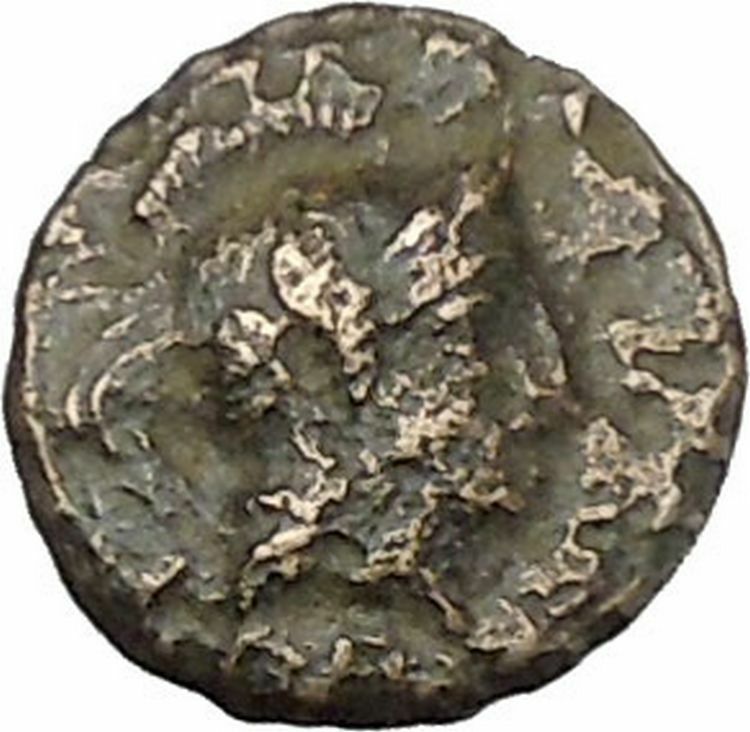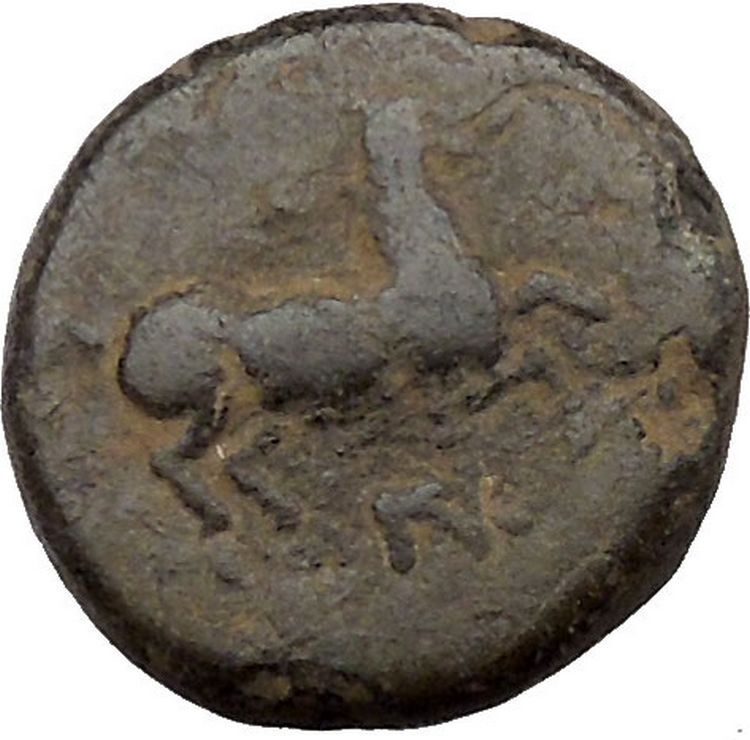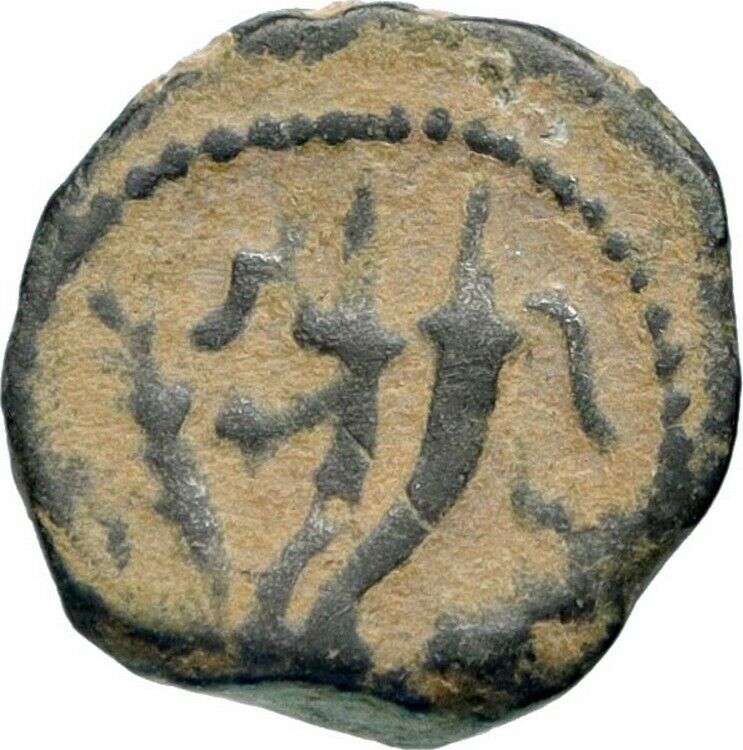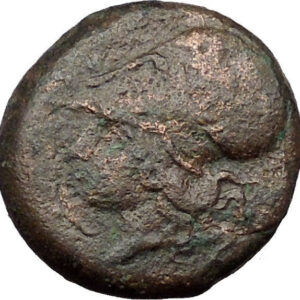|
Greek city of
Thasos
on Island in
the Thracian Sea
Silver 12mm (1.41 grams) Struck circa 350-200
B.C.
Reference: HGC 6, 365 var.
Head of Hercules Hercules
right, wearing lion’s skin headdress.
Strung bow (with amphora
inside) and club; ΘAΣ above.
You
are bidding on the exact item pictured, provided with a
Certificate of Authenticity and Lifetime Guarantee of
Authenticity.
HERCULES
– This celebrated of mythological romance was at first
called Alcides, but received the name of Hercules, or
Heracles, from the Pythia of Delphos. Feigned by the
poets of antiquity to have been a son of “the Thunderer,”
but born of an earthly mother, he was exposed, through
Juno’s implacable hatred to him as the offspring of
Alemena, to a course of perils, which commenced whilst
he was yet in his cradle, and under each of which he
seemed to perish, but as constantly proved victorious.
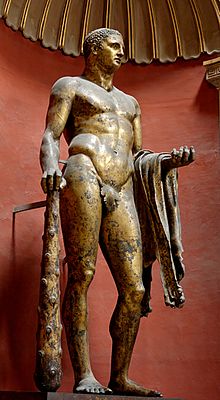
At
length finishing his allotted career with native valor
and generosity, though too frequently the submissive
agent of the meanness and injustice of others, he
perished self-devotedly on the funeral pile, which was
lighted on Mount Oeta. Jupiter raised his heroic progeny
to the skies; and Hercules was honored by the pagan
world, as the most illustrious of deified mortals. The
extraordinary enterprises cruelly imposed upon, but
gloriously achieved, by this famous demigod, are to be
found depicted, not only on Greek coins, but also on the
Roman series both consular and imperial. The first, and
one of the most dangerous, of undertakings, well-known
under the name of the twelve labors of Hercules, was
that of killing the huge lion of Nemea; on which account
the intrepid warrior is represented, clothes in the skin
of that forest monarch; he also bears uniformly a
massive club, sometimes without any other arms, but at
others with a bow and quiver of arrows. On a denarius of
the Antia gens he is represented walking with trophy and
club.
When his head alone is typified, as in Mucia gens, it is
covered with the lion’s spoils, in which distinctive
decoration he was imitated by many princes, and
especially by those who claimed descent from him – as
for example, the kings of Macedonia, and the successors
of Alexander the Great. Among the Roman emperors Trajan
is the first whose coins exhibit the figure and
attributes of Hercules.
An amphora (plural: amphorae or amphoras) is a type of
vase-shaped, usually
ceramic
(specimens in materials such as metal
occur occasionally) container with two handles and a long neck narrower than the
body. The word amphora is
Latin
, derived from the
Greek
amphoreus (αμφορεύς),
an abbreviation of amphiphoreus,
a compound word combining amphi- (“on both sides”, “twain”) plus
phoreus (“carrier”), from pherein (“to carry”), referring to the
vessel’s two carrying handles on opposite sides.
Further, the term also stands for an ancient
a title=”Ancient Roman units of measurement” href=”https://en.wikipedia.org/wiki/Ancient_Roman_units_of_measurement”>
Roman unit of measurement for liquids. The
volume of a Roman amphora was one cubic
foot
, ca. 26,026
L
.
Amphorae were used in vast numbers to transport and store various products,
both liquid and dry, in the ancient
Mediterranean
world and later the
Roman Empire
, and in some periods the shape was
also used for luxury pottery, which might be elaborately painted. Stoppers of
perishable materials which have rarely survived were used to seal the contents.
Two principal types of amphorae existed: the neck amphora, in which the
neck and body meet at a sharp angle; and the one-piece amphora, in which
the neck and body form a continuous curve. Neck amphorae were commonly used in
the early history of ancient Greece but were gradually replaced by the one-piece
type from around the 7th century BCE onwards. Most were produced with a pointed
base to allow upright storage by being partly embedded in sand or soft ground.
This also facilitated transport by ship, where the amphorae were tightly packed
together, with ropes passed through their handles to prevent breaking or
toppling during rough seas. In kitchens and shops amphorae could be stored in
racks with round holes in them.
Amphorae varied greatly in height. The largest could stand as much as 1.5
metres (5 ft) high, while some were under 30 centimetres (12 in) high – the
smallest were called amphoriskoi (literally “little amphorae”). Most were around
45 centimetres (18 in) high. There was a significant degree of standardisation
in some variants; the wine amphora held a standard measure of about 39 litres
(41 US qt), giving rise to the amphora quadrantal as a unit of measure in the
Roman Empire. In all, around 66 distinct types of amphora have been identified.
Thasos or Thassos (Greek:
Θάσος) is a
Greek
island in the northern
Aegean Sea
, close to the coast of
Thrace
and the plain of the river
Nestos
but geographically part of
Macedonia
. And it is where Clive Cussler novel “The
Mediterranean Caper” takes place.
//
History
Prehistory
Lying close to the coast of Eastern Macedonia, Thasos
was inhabited from the Palaeolithic period onwards,
but the earliest settlement to have been explored in
detail is that at Limenaria where Middle and Late
Neolithic remains have been found which relate closely
to those of the Drama Plain. In contrast, the remains of
the Early Bronze Age on the island align it with the
culture which developed in the Cylcades and Sporades to
the south in the Aegean. At Skala Sotiros
for example, a small settlement was encircled by a
strongly built defensive wall. Even earlier activity is
demonstrated by the presence of large pieces of
‘megalithic’ anthropomorphic stelai built into these
walls which, so far, have no parallels in the Aegean
area.
There is then a gap in the archaeological record
until the end of the Bronze Age c 1100 BC, when the
first burials took place at the large cemetery of Kastri
in the interior of the island.
Here built tombs covered with small mound of earth were
typical until the end of the Iron Age. In the earliest
tombs were a small number of locally imitated
Mycenaean
pottery vessels, but the majority of the
hand-made pottery with incised decoration reflects
connections eastwards with Thrace and beyond.
Antiquity
The island was colonized at an early date by
Phoenicians
, attracted probably by its gold mines;
they founded a temple to the god
Melqart
, whom the
Greeks
identified as
“Tyrian Heracles”
, and whose cult was merged with
Heracles in the course of the island’s Hellenization.
The temple still existed in the time of
Herodotus
.
An
eponymous
Thasos, son of Phoenix (or of Agenor, as
Pausanias reported) was said to have been the leader of
the Phoenicians, and to have given his name to the
island
.
In either 720 or 708 BC, Thasos received a
Greek
colony from
Paros
. It was in a war which the
Parian
colonists waged with the Saians, a Thracian
tribe, that the poet
Archilochus
threw away his shield. The Greeks
extended their power to the mainland, where they owned
gold mines which were even more valuable than those on
the island. From these sources the Thasians drew great
wealth, their annual revenues amounting to 200 or even
300 talents. Herodotus, who visited Thasos, says that
the best mines on the island were those which had been
opened by the Phoenicians on the east side of the island
facing
Samothrace
.
Thasos was important during the
Ionian Revolt
against Persia. After the capture of
Miletus
(494 BC)
Histiaeus
, the
Ionian
leader, laid siege. The attack failed, but,
warned by the danger, the Thasians employed their
revenues to build war ships and strengthen their
fortifications. This excited the suspicions of the
Persians, and
Darius
compelled them to surrender their ships and
pull down their walls. After the defeat of
Xerxes
the Thasians joined the Delian confederacy;
but afterwards, on account of a difference about the
mines and marts on the mainland, they revolted.
The Athenians defeated them by sea, and, after a
siege that lasted more than two years, took the capital,
Thasos, probably in 463 BC, and compelled the Thasians
to destroy their walls, surrender their ships, pay an
indemnity and an annual contribution (in 449 BC this was
21 talents, from 445 BC about 30 talents), and resign
their possessions on the mainland. In 411 BC, at the
time of the oligarchical revolution at Athens, Thasos
again revolted from Athens and received a Lacedaemonian
governor; but in 407 BC the partisans of Lacedaemon were
expelled, and the Athenians under
Thrasybulus
were admitted.
Roman
Era
After the
Battle of Aegospotami
(405 BC), Thasos again fell
into the hands of the
Lacedaemonians
under
Lysander
who formed a decarchy there; but the
Athenians must have recovered it, for it formed one of
the subjects of dispute between them and
Philip II of Macedonia
. In the embroilment between
Philip III of Macedonia
and the Romans, Thasos
submitted to Philip, but received its freedom at the
hands of the Romans after the
battle of Cynoscephalae
(197 BC), and it was still a
“free” state in the time of
Pliny
.
It is related, that Byzantine Greek Saint
Joannicius the Great
in one of his miracles freed
the island of Thasos from a multitude of snakes
(Venerable Joannicius lived through 8-9 centuries).
Ottoman
Era
Thasos was part of the
Eastern Roman Empire
, later known as
Byzantine Empire
. It was captured by the
Turks
in 1462. Under the Turks the island was known
as
Ottoman Turkish
: طاشوز Taşöz. A brief revolt
against Ottoman rule in 1821, led by Hajiyorgis Metaxas,
failed. The island was given by the Sultan
Mahmud II
to
Muhammad Ali of Egypt
of as a personal fiefdom in
the late 1820s, as a reward for Egyptian intervention in
the
War of Greek Independence
(which failed to prevent
the creation of the modern Greek state). Egyptian rule
was relatively benign (by some accounts Muhammad Ali had
either been born or spent his infancy on Thasos) and the
island became prosperous, until 1908, when the New Turk
regime asserted
Turkish
control. It had the status of a
sanjak
in the
vilayet
of Salonici until the
Balkan Wars
. On October 20, 1912 during the
First Balkan War
, a Greek naval detachment claimed
Thasos as part of
Greece
, which it has remained since.
World
War II
During Axis occupation (1941-1944) Thasos, along with
the rest of
Eastern Macedonia and Thrace
, was under Bulgarian
control. The Bulgarians planned to annex the territory
under their control and closed down schools as a first
step towards forced
Bulgarization
. Under Bulgarian rule the island was
called
Bulgarian
: Тасос.
Mountainous terrain facilitated small-scale resistance
activity. The
Greek Civil War
affected the island in the form of
skirmishes and
Communist
guerilla attacks until 1950, almost a year
after the main hostilities were over on the
mainland
.
Modern
Era
Thasos
, the capital (now informally known as Limenas,
or “the port”), stood on the north side of the island,
and had two harbors. Archilochus described Thasos as “an
ass’s backbone crowned with wild wood,” and the
description still suits the mountainous island with its
forests of fir and pine. Besides its gold mines, the
wine, nuts and marble of Thasos were well known in
antiquity. Thasian wine (a light bodied wine with a
characteristic apple scent) was, in particular, quite
famous; to the point where all Thasian coins carried the
head of the wine god
Dionysos
on one side and bunches of grape of the
other.
Today, Thasos is a part of the
Kavala prefecture
and is the southernmost and the
easternmost points in the prefecture. Under local
government reform in the late 1990s, the entire island
became a single municipality. Thasos is served ferry
routes to and from
Kavala
and Keramoti. The latter is a port at the
eastern portion of the prefecture, close to
Kavala International Airport
, and has the shortest
possible crossing to the island.
Geography

Thasos from space, April 1993
Thasos has generally round shape, without deep bays
and significant peninsulas. The highest peak, Ypsario or
Ipsario, is 1,205 m (3428 ft) high and lies in the
eastern half of the island, which is steeper and mostly
covered in pine forest. The western half has gentler
slopes. While generally mountainous, the terrain is not
particularly rugged, as it rises gradually from the
coast towards the island center.
Most villages were placed inland, as the population
was chiefly engaged in agriculture and stockbreeding.
Those villages had their harbors at nearest points on
the shore, often connected with stairways (“Skalas”) and
the population gradually migrated there, as tourism
began to emerge as an important source of income. Thus,
there are several pairs of villages such as Marion–Skala
Maries, where the former is inland and the latter on the
coast.
Geology

Geological and Metallogenic map of Thasos
Island.
Thasos island is located in the northern Aegean sea
approximately 7 km from the mainland and 20 km
south-east of
Kavala
. The Island is formed mainly by
gneisses
,
schists
and
marbles
of the
Rhodope
Massif. Marble sequences, corresponding to
the
Falacron
Marbles intercalated by schists and
gneisses, are up to 500m thick and are separated from
the underlying gneisses by a transition zone about 300 m
thick termed the T-zone consisting of alternances of
dolomitic and calcitic marbles intercalated by schists
and gneisses.
The rocks have undergone several periods of regional
metamorphism, to at least upper
amphibolite
facies, and there was a subsequent phase
of retrograde metamorphism. At least three periods of
regional deformation have been identified, the most
important being large scale
isoclinal
folding with axes aligned north-west. The
T-zone is deformed and is interpreted by some authors as
a regional thrust of pre-major folding age. There are
two major high angle fault systems aligned north-west
and north-east respectively. A large low-angle thrust
cuts the gneiss, schist and marble sequence at the
south-west corner of the island, probably indicating an
overthrusting of the Serbomacedonian Massif onto the
Rodope Massif.
The Late Miocene oil-producing Nestos-Prinos basin is
located between Thassos island and the mainland. The
floor of the basin is around 1,500 m deep off the
Thassos coast(South Kavala ridge; Proedrou, 1988) and up
to 4.000-5.000 m in the axial sector between Thassos and
the mainland. The basin is filled with Late
Miocene-Pliocene sediments, including ubiquitously
repeated evaporite layers of rock salt and
anhydrite-dolomite which alternate with sandstones,
conglomerates, black shales, and
uraniferous
coal measures (Proedrou, 1979, 1988;
Taupitz, 1985). Stratigraphically equivalent rocks on
the mainland are clastic sediments with coal beds,
marine to brackish fluvial units and travertines.
Mining
history
Mining activities for base and precious metals
started in the 7th century B.C. with the Phoenicians,
followed in the 4th century by the Greeks and then the
Romans. The mining was both open – pit and underground,
and concentrated on the numerous
karst
hosted calamine deposits for lead and silver
although there was also minor exploitation of gold and
copper. Worth mentioning is the discovery of a
paleolithic addit located at Tzines iron mine, whose age
has being estimated at approximately 15.000 years old, (Kovkouli
et al. 1988) for the exploitation of
limonitic
ochre.
Economy
The main agricultural production on the island are
honey
and
olive oil
as well as
wine
,
sheep
,
goat
herding and fishing. Other industries includes
lumber and tourism. Mining industry includes lead, zinc
and marble, especially in the Panagia area where one of
the mountains near the Thracian Sea has a large marble
quarry. Now abandoned marble quarry in the south (in the
area of Aliki) has been mined during the ancient times.
By far the most important economic activity is tourism.
|











